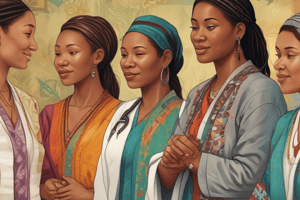Podcast
Questions and Answers
What is the incidence of dyspnea in oncological patients?
What is the incidence of dyspnea in oncological patients?
- 91-100%
- 50-70%
- 1-10%
- 21-90% (correct)
What is the primary psychological effect of dyspnea?
What is the primary psychological effect of dyspnea?
- Social isolation
- Anxiety (correct)
- Panic
- Loss of enjoyment of life
What is the sensation of dyspnea arising from?
What is the sensation of dyspnea arising from?
- Awareness of a respiratory supply-and-demand mismatch (correct)
- Neuromuscular disease
- Direct tumor effects on the lungs
- Cardiovascular disease
What is a common cause of dyspnea in oncological patients?
What is a common cause of dyspnea in oncological patients?
What is the most common reason for visits to the emergency department?
What is the most common reason for visits to the emergency department?
What is the mechanism of dyspnea in patients with lymphangitic carcinomatosis?
What is the mechanism of dyspnea in patients with lymphangitic carcinomatosis?
What is a treatment-related cause of dyspnea?
What is a treatment-related cause of dyspnea?
What is the role of chemoreceptors in the pathophysiology of dyspnea?
What is the role of chemoreceptors in the pathophysiology of dyspnea?
What is a non-malignant cause of dyspnea?
What is a non-malignant cause of dyspnea?
What is the result of dyspnea on patients and caregivers?
What is the result of dyspnea on patients and caregivers?
Study Notes
Vietnamese Cultural Considerations
- In Vietnam, the eldest male is often the family spokesman, and older women may also have significant influence.
- Decisions are often made by the eldest male, but if the patient does not want to make their own medical decisions, a Durable Power of Attorney for healthcare needs to be prepared.
- Removal of life support may require extensive family discussion, placing the responsibility for the decision on the entire family rather than on one individual.
Respect for Elders and Authority
- Patients may have a deep respect for elders and people with authority, which may lead them to be reluctant to say "no" to a doctor or healthcare provider.
- Asking about "Do Not Resuscitate" orders and documenting these wishes can give patients and their families a sense of security.
Views on Pain, Illness, and Treatment
- Patients may accept pain and illness in a stoic manner, motivated by a strong desire to go home.
- Patients may mask their pain, and surgery may be seen as a treatment of last resort.
- Blood loss, including blood drawn for lab tests, may be believed to make patients sicker.
Vietnamese Rituals and Religious Practices
- Most Vietnamese are Buddhist, with other religious preferences including Catholic, Evangelical Protestant, and Chinese Confucianism.
- Patients may call a monk to give blessings, chant, and create an altar for prayer.
- Catholic patients may ask for a priest for last rites at the end of life.
Importance of Food and Mourning
- Food is considered important for health in Vietnamese culture, and family members may force food on patients when they are ill.
- White is the color of mourning in Vietnamese culture.
Effective Communication
- Ask questions before entering the room to ensure a good time to talk, assess the patient's and family's needs, and avoid overwhelming them with information.
- Use active attentive listening, nodding, and reflective statements to encourage communication.
- Avoid giving advice unless asked, and build on the patient's responses to guide the conversation.
SPIKES Protocol
- Give information in small amounts, using the "warning shot" principle to facilitate understanding.
- Check understanding frequently and reinforce with plain language.
- Emphasize empathic responses to the patient's emotions and reactions.
Palliative Care and End of Life Care
- Managing physical and psychological symptoms alleviates distress and suffering.
- Dyspnea is a common symptom in oncological patients, causing multidimensional distress and affecting quality of life.
- Dyspnea can be caused by various factors, including direct tumor effects, treatment-related effects, cardiovascular disease, pulmonary disease, and anxiety.
Pathophysiology of Dyspnea
- Respiratory control involves input from various receptors in the chest wall, airways, and chemoreceptors in blood vessels.
- Dyspnea arises from the awareness of a respiratory supply-and-demand mismatch.
Studying That Suits You
Use AI to generate personalized quizzes and flashcards to suit your learning preferences.
Related Documents
Description
This quiz assesses your understanding of cultural nuances in healthcare decision-making, including the role of family members and the importance of communication.




